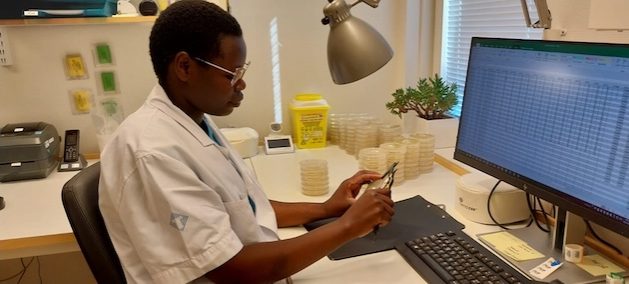
BULAWAYO, Could 20 2025 (IPS) – Extra persons are dying from as soon as treatable infections as a result of the medicines we depend on are now not working as they need to. The perpetrator? A rising well being menace known as antimicrobial resistance (AMR).
What’s AMR?
AMR occurs when micro organism, viruses, fungi, or parasites evolve and develop into immune to the medication meant to kill them—this makes widespread infections more durable and generally not possible to deal with. With out efficient medication, ailments last more, unfold extra simply, and trigger extra deaths. Why? Antimicrobials have gotten much less efficient in treating infections as a result of disease-causing germs have gotten resistant.
“AMR is a world disaster that’s already right here,” Dr. Arshnee Moodley, a microbiologist and staff chief for Antimicrobial Resistance on the Worldwide Livestock Analysis Institute (ILRI), informed IPS by way of e-mail.
“It makes infections in folks, animals, and even crops more durable—or generally not possible—to deal with,” Moodley says. “With out working medicines, sicknesses that had been as soon as routine can develop into life-threatening.”
The rise in AMR has made it tougher to stop and deal with infections with medicines like antimicrobials.
What are antimicrobials and are they essential for well being?
Antimicrobials are essential medicines and embrace antibiotics, antifungals, antivirals, and antiparasitics, that are used to both forestall or deal with infections in people, animals, and crops. They’re important to trendy drugs and veterinary care. With out them, we danger shedding the power to deal with infectious ailments and defend our meals programs.
Why is that this occurring? Ought to we be fearful about AMR?
Think about not having drugs that works once you get an an infection. For instance, through the COVID-19 pandemic, the world scrambled to search out methods to deal with and handle a brand new illness.
AMR is basically pushed by the overuse and misuse of antimicrobials in people, animals, and agriculture. They’re usually used after they’re not wanted or within the unsuitable doses. In farming, they’re generally used to advertise progress or make up for poor hygiene somewhat than deal with illness. This overuse provides microbes extra probabilities to adapt and develop into resistant, turning these life-saving medicines into ineffective instruments.
The World Financial institution, the World Organisation for Animal Well being, and AMR all warn that with out motion, AMR might trigger vital financial hurt on the dimensions of the 2008 international monetary disaster. The World Financial institution estimates that by 2050, AMR might wipe away 3.8 % of worldwide gross home product every year and push 28 million folks into poverty. The lack of productiveness in agriculture, particularly livestock programs, might severely have an effect on meals programs and livelihoods.
Who’s most affected?
Whereas AMR is a world burden, low- and middle-income nations like Kenya bear the best burden. Restricted entry to diagnostics, vaccines, and applicable therapy signifies that drug-resistant infections usually go undetected or are handled incorrectly. Farmers can lose whole herds or flocks resulting from untreatable infections, resulting in meals insecurity and lack of revenue. In keeping with latest estimates, AMR instantly causes 1.27 million deaths yearly and contributes to almost 5 million extra. That’s on par with HIV/AIDS and malaria.

Does local weather change have a task in AMR?
Sure, local weather change is an rising issue within the unfold and worsening of AMR. Rising temperatures, excessive climate, and flooding can alter the unfold of pathogens and the appliance of antimicrobials, based on a latest evaluate through which ILRI participated. For instance, hotter situations assist micro organism develop quicker and share resistance genes extra simply. Floods can unfold drug-resistant pathogens from sewage into water provides, rising the chance of infections in each folks and animals. Animals harassed by warmth might develop into extra susceptible to illness, resulting in elevated use of antimicrobials.
“There may be additionally one other hyperlink between AMR and local weather change,” Moodley informed IPS. “Residues of antimicrobials in manure can disrupt microbial processes in soil, probably affecting greenhouse fuel emissions. And we at ILRI are learning how antibiotics in livestock manure—due to therapy—have an effect on greenhouse fuel emissions and soil well being.”
Can we battle AMR?
Sure. AMR is preventable, but it surely requires pressing motion throughout all sectors. Vaccination can forestall infections and scale back the necessity for antibiotics. Improved diagnostics can guarantee the precise drug is used solely when essential. Higher hygiene and an infection prevention in hospitals, farms, and communities can scale back illness unfold. Accountable antimicrobial use in each animals and people is vital to slowing AMR.
“Whereas drug-resistant infections are a priority,” Moodley says, “We should not neglect that many individuals nonetheless don’t have entry to the fundamental well being and veterinary companies they want—together with the very medicines, vaccines, and diagnostics that would save lives and stop AMR.”
The underside line
AMR threatens the way forward for healthcare, agriculture, and international growth. It undermines progress towards Common Well being Protection and Sustainable Improvement Targets like zero starvation (SDG 2) and good well being and well-being (SDG 3). This silent pandemic is unfolding now and with out pressing, coordinated motion, the world dangers coming into a post-antibiotic period the place even the smallest infections can as soon as once more kill.
Be aware: This characteristic is printed with the help of Open Society Foundations.
IPS UN Bureau Report
Observe @IPSNewsUNBureau
Observe IPS Information UN Bureau on Instagram
© Inter Press Service (2025) — All Rights Reserved. Unique supply: Inter Press Service











